
An Inside Glimpse of the World's Biggest Space Telescope
By Yohani Kamarudin, Tech Graffiti, 20 January 2013.
By Yohani Kamarudin, Tech Graffiti, 20 January 2013.
Cryogenic testing being performed on the telescope’s flight mirrors at NASA’s Marshall
Space Flight Centre in Alabama. Image: Ball Aerospace.
We may not be able to travel back in time, but once the currently-under-construction James Webb Space Telescope (JWST) is completed, we’ll be able to see 13 billion light years into space! That’s far enough back to witness the creation of the universe’s first stars and galaxies! To achieve this, an extraordinary instrument is needed; in fact, no less than what, come 2018, will be the biggest telescope ever sent into orbit.
Ball Aerospace’s Jake Lewis inspects the mirrors in NASA’s X-ray and Cryogenic Facility
for Testing. Image: NASA/MSFC/David Higginbotham/Emmett Given.
The JWST is the successor to two previous telescopes: the Hubble Space Telescope and the Spitzer Space Telescope. About 17 countries - led by NASA with assistance from the European and Canadian space agencies - have been working on the project since 1996. The final telescope will cost $8 billion - which even taking into account inflation is twice as expensive as the Hubble Telescope cost by the time it was launched into Earth’s orbit in 1990. In fact, in 2011 the JWST was almost cancelled for being too expensive, but fortunately funding was resumed, and the gigantic telescope will now be launched in 2018.
A full-scale model of the James Webb Space Telescope, located at the
Maryland Science Centre in Baltimore. Image: NASA/Ed Campion.
The physical proportions of the JWST will be suitably enormous. For one, this gigantic undertaking incorporates a 21-foot (6.5-meter) diameter mirror with a tennis court-sized sunshield. The mirror is made up of 18 hexagonal segments, each of them four feet (1.3 meters) in diameter, made of beryllium coated with gold, and polished to a high shine.
A gold-coated segment of the engineering design unit’s primary mirror at the Ball
Aerospace and Technology Corp. Image: Drew Noel.
What the JWST will actually see as it peers back all those billions of years are traces of infrared light from distant galaxies. Infrared light (IR) waves can’t be seen with the naked eye because IR light is not in the visible spectrum. However, when detected with instruments like the JWST, these light waves provide scientists with invaluable information about the way the universe works (and used to work, long before we were around to observe it).
A life-sized sunshield membrane being tested at ManTech, Huntsville.
The telescope is made up of three parts: the Integrated Science Instrument Module, the Optical Telescope Element, and the Spacecraft Element. As mentioned, the mirror used to detect the infrared rays is covered with reflective gold - and this increases the mirror’s ability to reflect infrared light. And when you think about trying to get a mirror this size into space, why it’s made up of hexagonal segments might become apparent: to make it easier to fold up and fit into a rocket.
A segment of the telescope’s primary mirror. Image: Drew Noel.
Besides size, another important aspect of the JWST is temperature. In order to measure the incoming infrared light accurately, the mirror will need to be “cryogenically” chilled - to an astounding -364° F (-220° C)! To achieve this, it will be shot deep into space, with attached sunshields used to protect it from the warmth of the Sun and the heat given off by the spacecraft bus (which houses six major subsystems: electrical power, attitude control, communications, command and data handling, propulsion, and thermal control).
A sunshield membrane ready to be precisely measured.
The sunshields are arranged in five roughly kite-shaped layers that, oddly enough, look a bit like space blankets. The reason for this layered approach is that it allows for better heat deflection, since the vacuum between each sheet acts as a strong insulator. Most of the heat the sunshields are designed to deflect comes from the Sun, which, along with the Earth and Moon, will always be kept to one side of them, with the mirror pointing in the other direction.
The reflective qualities of the mirror segments are impressive; this one was photographed
at the Ball Aerospace and Technology Corp. Image: Drew Noel.
Most of the real science happens behind the giant gold mirror. This is where the Integrated Science Instrument Module (ISIM) lies. It contains the Near Infrared Camera, or NIRCam, together with four other scientific instruments. The NIRCam is one of the most important parts of the JWST. This amazing camera will detect light from the beginning of the universe, when the original stars and galaxies were still forming, as well as from more recent star formations. The NIRCam is able to focus on dimmer objects - for example, planets orbiting stars - by blocking the light from the brighter object. This will allow scientists to study these planets and their characteristics.
Six of the 18 JWST mirrors are readied to be shipped to NASA’s Marshall Centre, where
they will be cryogenically tested. Image: NASA/MSFC/David Higginbotham/Emmett Given.
Another vital instrument is the Near Infrared Spectograph (NIRSpec), which (like the NIRCam) also picks up infrared light. The NIRSpec then breaks this light down into its various components, ready to be analyzed by scientists. The scientists will use the information to learn about the object from which the light was emitted - for example, how far away it is, its temperature, and what it is made from. But that’s not all. The NIRSpec will also provide information on the formation of new stars. What can be learned from light waves is really quite incredible!
The Hubble Space Telescope excites the world with high-quality astrophotography, and so
will the JWST. Image: Mark Clampin.
Also on board the JWST is the Mid-Infrared Instrument (MIRI). This is a camera and a spectrograph. Distant comets, the birth of stars and faraway galaxies will all be observable thanks to its super sensitive detectors. And through the MIRI we will also get breathtaking broadband, wide-field astrophotography. Stunning images from space have made the Hubble Telescope hugely popular, and the JWST will be just as exciting.
Scientists reflected in a gold-coated segment of the engineering design unit’s primary
mirror. Image: Drew Noel.
There are two further significant instruments aboard the JWST: the Near-Infrared Imager and Slitless Spectrograph (NIRISS), and the Fine Guidance Sensor (FGS). The NIRISS is another spectrograph, and it will use a variety of filters to find new galaxies, analyze the atmosphere of planets within our own galaxy, and make complex maps of objects like quasars.
The FGS is not a piece of imaging equipment, but rather a guidance system that helps point the JWST in the right direction. It does this by taking a picture of a star close to the object of interest. It then uses the star as a guide so as to focus on a certain area. As long as the FGS can hold the star in the exact same position, the JWST is pointed in the right direction. As the telescope will occasionally move due to exterior and interior factors, the FGS measures the position of the guide star at a rate of 16 times a second. This way, any changes in position can be detected and corrected by the computer.
The Optical Telescope Element Simulator being lowered into a vacuum chamber for testing.
Image: NASA Goddard/Chris Gunn.
Here, the OTE (Optical Telescope Element) Simulator, or OSIM, is seen wrapped in a silver blanket and being lowered down into a vacuum chamber (called the Space Environment Simulator, or SES) by a crane, ready to be tested. It’s important in order to find out whether the OSIM can withstand the cold temperatures of space.
Of course, all this high-end technology is of little use unless it’s powered up and functional. This is where the spacecraft bus and its electrical power subsystem come in. The JWST will be solar powered - using solar array panels the energy from which the electrical power subsystem converts into power. This electricity is then used to keep the other subsystems and the scientific instruments working properly.
The Integrated Science Instrument Module undergoing cryogenic testing.
Image: Chris Gunn/NASA.
Understandably, constructing all these complex individual components takes time and resources. Much of the technology used on the JWST is new and was invented specifically for its operation. Moreover, each part has to be tested, to be sure that it can survive the rigors of launching and space. The parts need to be tested on their own, with their units, and finally as part of the telescope as a whole. No wonder more than 100 companies are involved in the development and construction! However, all this research and testing will be worth it, as servicing and repairing such telescopes in space is difficult and very expensive.
A scientist wears protective clothing as a mirror segment is inspected.
Image: NASA/Chris Gunn.
Once operational, the JWST will provide scientists with invaluable information about the universe. The telescope’s mission has four elements: to look at the universe after the Big Bang; to study the beginnings of galaxies as well as how they evolve; to comprehend the “the formation of stars and planetary systems”; and to study those planetary systems and see what they can tell us about the very origins of life. And, as with the Hubble, we also expect the JWST to provide us with some breathtaking astrophotography.
Top image: September 2009 artist conception of the James Webb Space Telescope. Image/more info via: NASA.

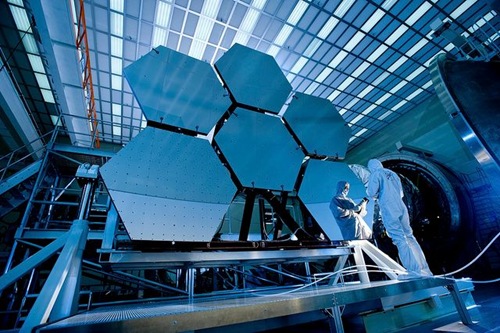
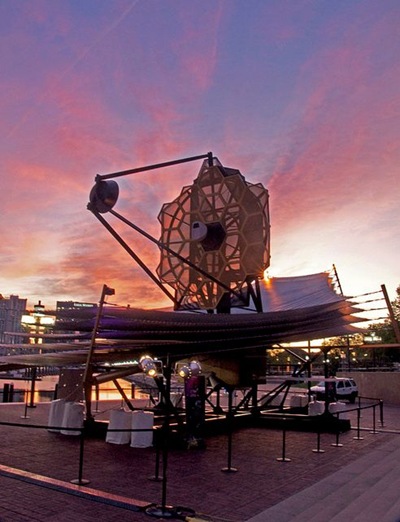
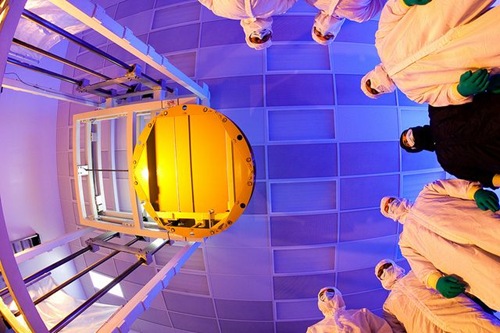
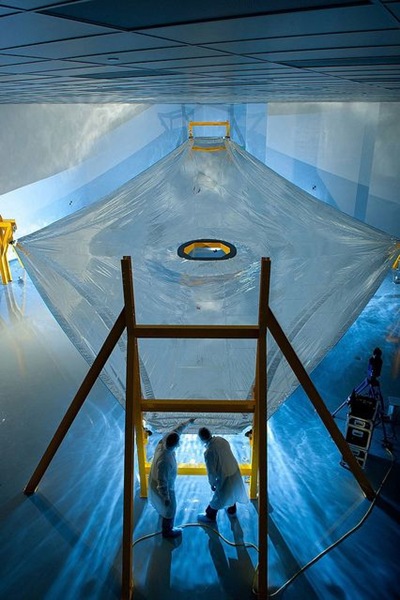

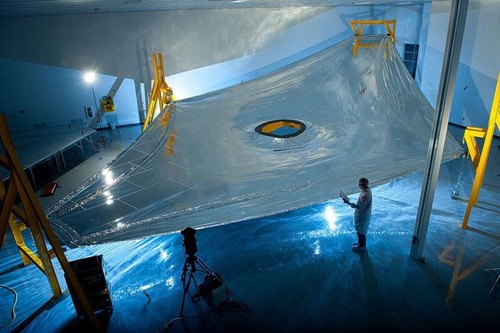

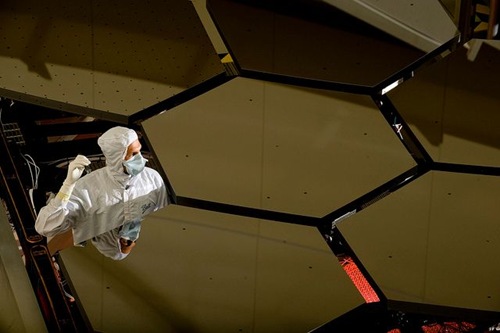
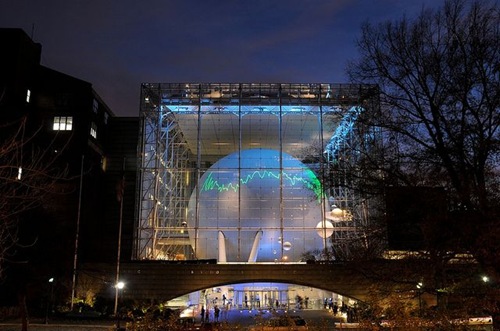
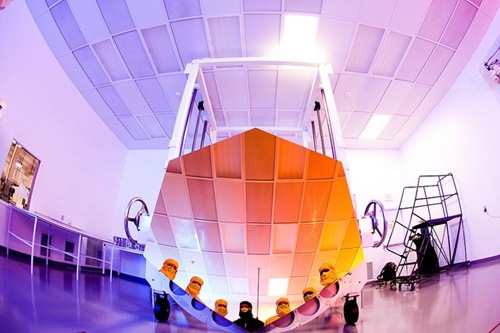
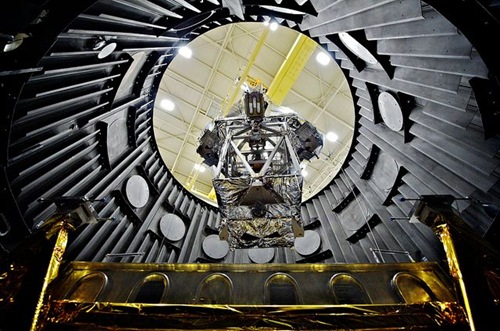

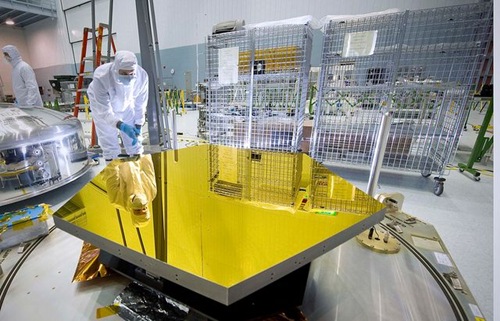
No comments:
Post a Comment
Please adhere to proper blog etiquette when posting your comments. This blog owner will exercise his absolution discretion in allowing or rejecting any comments that are deemed seditious, defamatory, libelous, racist, vulgar, insulting, and other remarks that exhibit similar characteristics. If you insist on using anonymous comments, please write your name or other IDs at the end of your message.